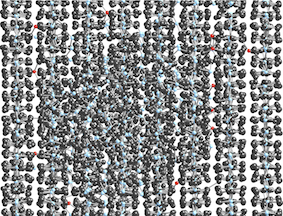Nuclear power is likely to have an important role in securing energy requirements of the future as part of a mixed portfolio of energy sources, and currently contributes signicantly to the current UK energy usage. Materials research is essential to ensuring that nuclear powder is both safe and efficiently, and in ensuring that nuclear waste can be stored safely. In all these cases one common problem is that of understanding how materials respond to the effects of radiation and radioactive decay. We are running research programmes in several areas, mostly based on performing molecular-scale simulations that need to be extraordinarily large (record breaking) to accommodate the high energies of atoms recoiling from nuclear alpha decay processes. For this work we have a strong involvement, through collaboration, in the development of the methods.

We have developed a strong programme of working investigating materials that are suitable for encapsulating high-level radioactive materials, such as waste plutonium. This is an important societal problem for which there is not yet an agreed solution. We have been investigating the potential to store radioactive elements within crystalline ceramics, in part motivated by the fact that in nature radioactive elements have been stored for millions of years in minerals such as zircon (ZrSiO4). Working with colleagues in the National Nuclear Laboratory we have been performing large-scale simulations of the effects of high-energy atomic recoils on the structure of candidate materials, as illustrated on the right. From this work we have developed insights into the factors that enable crystalline order to be restablished in some materials but not others, and to understand the way in which long-lived disorder will affect the leaching of radiactive cations. Similar work is also being developed for work on the radiation damage in nuclear fuel elements, particularly for future-generation fuels, concerned with understanding the durability of fuel within new fission reactors. We also have a programme of work simulating radiation damage in metals, motivated by the need to understand the behaviour of materials in a highly-radioactive environment. This is important both for nuclear fission and future fusion reactors. Of particular interest is the possibility to use metals with low-density structures. For more information on this work, please contact Dr Trachenko or Prof. Dove.
The challenge of generating electricity from light is of paramount importance in the search for ecologically friendly power sources. Research in this field is led by Dr Dennis, Dr Kreouzis, Dr Sapelkin, and Prof. Gillin.
Materials for drug delivery can play a key role in transporting medicine to the organs it is designed to treat and limiting side effects from drug toxicity. Our work on these materials is led by Dr Baxendale, Dr Sapelkin, and Dr Dennis.
Porous materials for carbon capture could be an effective way of limiting emissions. For more information, please contact Dr Misquitta or Prof. Dove.
We also have a research programme trying to understand the changes in structure within batteries and fuel cells as they go through the charge-discharge cycle. For more information, contact Prof. Dove.
